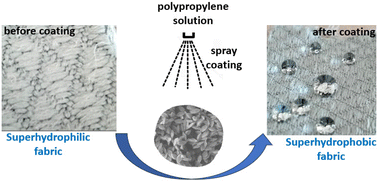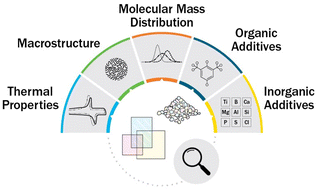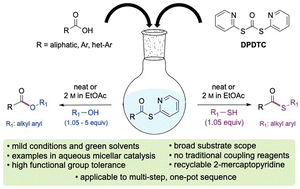Themed collection Green Chemistry 25th Anniversary Collection

Glycerol and its Derivatives as Potential C-3 Bio-based Building Blocks for Accessing Active Pharmaceutical Ingredients
Green Chem., 2024, Accepted Manuscript
https://doi.org/10.1039/D4GC01957A
A promise to a sustainable future: 10 years of the Green Chemistry Commitment at Beyond Benign
The Green Chemistry Commitment (GCC) was founded in 2013 to host a community of practice around green chemistry in higher education. 10 years later, the GCC empowers a worldwide community to use chemistry tools to create a sustainable planet.

Green Chem., 2024,26, 6983-6993
https://doi.org/10.1039/D4GC00575A
On the role of surfactants: rethinking “aqueous” chemistry
Some of the latest technological developments involving chemistry in water are discussed.

Green Chem., 2024,26, 739-752
https://doi.org/10.1039/D3GC03875K
The need for hotspot-driven research
Environmental benefit will be greatest if we green the step causing the most harm.

Green Chem., 2023,25, 9457-9462
https://doi.org/10.1039/D3GC03601D
The Advanced Applications of Ionic Liquids in New Energy, Electronic Information Materials, and Biotechnologies
Green Chem., 2024, Accepted Manuscript
https://doi.org/10.1039/D4GC01519C
Balancing computational chemistry's potential with its environmental impact
Digital chemistry methods accelerated discoveries of sustainable processes but require assessing and minimizing their carbon footprint caused by the required computing power.

Green Chem., 2024, Advance Article
https://doi.org/10.1039/D4GC01745E
Methanesulfonic acid (MSA) in clean processes and applications: a tutorial review
Methanesulfonic acid (MSA) bridges organic and inorganic green chemistry since it is a strong non-oxidizing organic acid with a very low vapor pressure and forming highly soluble metal salts.

Green Chem., 2024, Advance Article
https://doi.org/10.1039/D4GC02031F
Nature-inspired batteries: from biomaterials to biomimetic design strategies
Bio-inspired materials and design serve as a source of inspiration for the design of electrodes, electrolytes, interfaces and devices, inducing flexibility, selective ionic transport, self-healing properties or biodegradability.

Green Chem., 2024,26, 6944-6958
https://doi.org/10.1039/D4GC00638K
Next-generation nitrogen fixation strategy: empowering electrocatalysis with MXenes
Green Chem., 2024, Accepted Manuscript
https://doi.org/10.1039/D4GC01566E
Deep eutectic solvents towards green polymeric materials
Solvents are essential for chemical synthesis and material preparation; however, traditional solvents face challenges in meeting safety and sustainability standards.

Green Chem., 2024, Advance Article
https://doi.org/10.1039/D4GC00532E
Safe and sustainable chemicals and materials: a review of sustainability assessment frameworks
Indicators and methods for safe and sustainable by design chemicals and materials.

Green Chem., 2024,26, 7456-7477
https://doi.org/10.1039/D3GC04598F
Deep eutectic solvents as green solvents for materials preparation
DESs play a Janus role (chemical or physical) in the preparation of materials. The physical aspect includes solvating, exfoliating, dispersing and confining, while the chemical part includes reacting, composing, polymerizing and modifying.

Green Chem., 2024,26, 7478-7507
https://doi.org/10.1039/D4GC00136B
Solvent effects on carbohydrate transformation: insights into chemical pathway modulation
Solvent effects are pivotal steps in carbohydrate utilization by modulating solute-solvent interactions.

Green Chem., 2024,26, 6900-6925
https://doi.org/10.1039/D3GC04901A
From waste to resource: advancements in sustainable lignin modification
An overview on lignin modification and applications possibilities is provided. Importantly, a quantitative comparison of all discussed literature procedures in terms of sustainability is included.

Green Chem., 2024,26, 4358-4386
https://doi.org/10.1039/D4GC00745J
Improved separation of rare earth elements using hydrophobic deep eutectic solvents: liquid–liquid extraction to selective dissolution
Tuning steric environment of hydrophobic deep eutectic solvents improves dissolution selectivity of rare earth elements.

Green Chem., 2024, Advance Article
https://doi.org/10.1039/D4GC01089B
Continuous-flow directed C–H amidation reactions using immobilized Cp*Rh(III) catalysts
A highly efficient heterogeneous Cp*Rh(III) catalysts were developed for continuous-flow C–H amidation reactions of phenyl pyridines. The catalyst maintained the activity for 200 h continuous reaction without leaching of Rh species.

Green Chem., 2024, Advance Article
https://doi.org/10.1039/D4GC01747A
Electrochemical depolymerisation of polylactic acid
Herein, we present electrochemical depolymerisation as a promising new technique for chemical recycling of polylactic acid.

Green Chem., 2024,26, 6423-6428
https://doi.org/10.1039/D3GC04234K
Scalable superhydrophobic coatings with recycled polypropylene
Overcoming solubility challenges in polypropylene (pp) coatings: a scalable, environmentally friendly approach utilizing partial oxidation and recycled materials.

Green Chem., 2024,26, 4493-4497
https://doi.org/10.1039/D4GC00221K
Non-noble metal heterogeneous catalysts for hydrogen-driven deoxydehydration of vicinal diol compounds
A non-noble metal catalyst, MoOx–Cu–Na/TiO2, was found to be highly efficient in the deoxydehydration (DODH) of vicinal diols into olefinic compounds.

Green Chem., 2024,26, 8267-8281
https://doi.org/10.1039/D4GC02006E
Cycloaddition–dehydration continuous flow chemistry for renewable para-xylene production from 2,5-dimethylfuran and ethylene over phosphorous-decorated zeolite beta
Continuous manufacturing of platform chemicals from lignocellulose is highly desirable for a fossil fuel independent future.

Green Chem., 2024, Advance Article
https://doi.org/10.1039/D4GC01904K
The need to integrate mass- and energy-based metrics with life cycle impacts for sustainable chemicals manufacture
Analysis of over 700 chemical production routes showing that decision making towards more environmentally sustainable pathways is enhanced by combining mass- and energy-based process metrics with simplified life cycle impact indicators.

Green Chem., 2024, Advance Article
https://doi.org/10.1039/D4GC00394B
Development of a solvent sustainability guide for the paints and coatings industry
A guide has been developed, highlighting various sustainability criteria of solvents used in the paints and coatings industry.

Green Chem., 2024, Advance Article
https://doi.org/10.1039/D4GC01962H
Liquid-phase hydrogenation of carbon monoxide to methanol using a recyclable manganese-based catalytic system
A simple and recyclable homogeneous catalytic system for the hydrogenation of carbon monoxide to methanol was established.

Green Chem., 2024,26, 7799-7805
https://doi.org/10.1039/D4GC01050G
Molecular structure and composition elucidation of an industrial humin and its fractions
The structure of humins, a major side-product of carbohydrate biorefining, is complex and to a large extent unknown. A multitechnique characterization of an industrial humin provides new structural insights.

Green Chem., 2024,26, 7739-7751
https://doi.org/10.1039/D4GC00429A
Manganese-catalyzed nucleophilic addition of aldehydes to carbonyl compounds via hydrazone umpolung on water
Herein, we report an operationally simple addition of hydrazones to carbonyl compounds using an earth-abundant metal, under aqueous and aerobic conditions.

Green Chem., 2024,26, 7357-7362
https://doi.org/10.1039/D4GC01516A
Carbon-negative hydrogen: aqueous phase reforming (APR) of glycerol over NiPt bimetallic catalyst coupled with CO2 sequestration
Carbon-negative H2 can be produced by coupling APR technology with CO2 sequestration. APR of glycerol over NiPt bimetallic catalyst coupled with CCUS can produce H2 with negative GHG emissions (–57 CO2 eq. per kg H2) using renewable electricity.

Green Chem., 2024,26, 7212-7230
https://doi.org/10.1039/D4GC01896F
Characterization of polymer properties and identification of additives in commercially available research plastics
This work reports the analysis of 59 commercially available polymers from 20 different polymer classes for thermal properties, macrostructure, molecular mass distribution, and inorganic and organic additives, highlighting the need to characterize research polymers prior to recycling studies.

Green Chem., 2024,26, 7067-7090
https://doi.org/10.1039/D4GC00659C
Selective hydrogenolysis of furfural to 1,2-pentanediol over a Pt–Fe/MT catalyst under mild conditions
A Pt–Fe bimetallic catalyst is developed to produce 1,2-pentanediol from furfural under mild conditions of 140 °C and 0.1 MPa H2, affording by far the highest production rate.

Green Chem., 2024,26, 6511-6519
https://doi.org/10.1039/D4GC00642A
Integrating climate policies in the sustainability analysis of green chemicals
The grand transition towards green pathways for chemical production, alongside ambitious climate policies, could achieve 90% reduction in climate change impacts by 2050, while fossil routes offer a reduction of 10% in the best case.

Green Chem., 2024,26, 6461-6469
https://doi.org/10.1039/D4GC00392F
Highly-stable Silverton-type UIV-containing polyoxomolybdate frameworks for the heterogeneous catalytic synthesis of quinazolinones
The first series of Silverton {UMo12O40}-based polyoxomolybdates linked by FeII, CoII, and NiII were synthesized and characterized. They exhibited excellent stabilities and were used as heterogeneous catalysts for the synthesis of quinazolinones.

Green Chem., 2024,26, 6454-6460
https://doi.org/10.1039/D4GC00877D
Early-stage impact assessment tool (ESTIMATe) for the life cycle assessment of CO2-based chemicals
The open-source Excel LCA tool ESTIMATe allows non-LCA experts to assess the environmental impact of CCU chemicals.

Green Chem., 2024, Advance Article
https://doi.org/10.1039/D4GC00964A
Counter-current chromatography for lignin monomer–monomer and monomer–oligomer separations from reductive catalytic fractionation oil
Counter-current chromatography is an effective unit operation for simultaneous aromatic monomer–monomer and monomer–oligomer separations from oil derived from reductive catalytic fractionation of lignocellulosic biomass.

Green Chem., 2024,26, 5900-5913
https://doi.org/10.1039/D4GC00765D
C(sp2)–S cross-coupling reactions with nickel, visible light, and mesoporous graphitic carbon nitride
Operationally simple photo-nickel C(sp2)–S cross-coupling with a reusable heterogeneous photocatalyst.

Green Chem., 2024,26, 5845-5851
https://doi.org/10.1039/D3GC04517J
Mechanochemical and aging-based reductive amination with chitosan and aldehydes affords high degree of substitution functional biopolymers
A solid-phase method favors the formation of Shiff-bases from chitosan and aldehydes and subsequent reduction. This provides access to alkylated chitosans with high degrees of functionalization with low process mass intensity.

Green Chem., 2024,26, 5386-5396
https://doi.org/10.1039/D4GC00127C
Interactions of multiple metrics and environmental indicators to assess processes, detect environmental hotspots, and guide future development
Sustainable development of pharmaceuticals relies on the selection and integration of unified metrics and indicators. Herein, we present a standardized method to assess, report, and communicate environmental sustainability of development processes.

Green Chem., 2024,26, 5239-5252
https://doi.org/10.1039/D4GC00302K
Chemoenzymatic synthesis of amino-esters as precursors of ammonium salt-based surfactants from 5-hydroxymethylfurfural (HMF)
Precursors of ammonium salt biosurfactants have been obtained from HMF by coupling cobalt-catalyzed reductive amination with selective bio-esterification using an immobilized lipase CALB. The process has been optimized in batch and flow reactors.

Green Chem., 2024, Advance Article
https://doi.org/10.1039/D4GC00425F
Chemical valorisation of biomass derived furanics and carboxylic acids over niobium-based catalysts
Reaction and substrate scopes may be considerably broadened in the context of the chemical valorisation of biomass, using stable solid acid catalysts consisting of nanostructured silica–niobia which outperformed pure niobia and other catalysts.

Green Chem., 2024,26, 4820-4833
https://doi.org/10.1039/D4GC00207E
A robust heterogeneous chiral phosphoric acid enables multi decagram scale production of optically active N,S-ketals
A multi-decagram scale synthesis of enantioenriched N,S-ketals was achieved by using a robust heterogeneous organocatalyst. A new reactor design was crucial to enable the scaling up of this reaction while the overall catalyst loading below 0.1%.

Green Chem., 2024,26, 4593-4599
https://doi.org/10.1039/D4GC00019F
A novel approach to amino acid synthesis: acid-assisted reactions with dimethyl carbonate for efficient O-methylated, N,O-methylated and N-formylated derivatives
A novel and efficient method has been developed for the modification of amino acids using a dimethyl carbonate (DMC) in an acidic system.

Green Chem., 2024,26, 3747-3757
https://doi.org/10.1039/D3GC03455K
Direct amination of poly(p-phenylene oxide) to substituted anilines over bimetallic Pd–Ru catalysts
We demonstrate a novel route for the upcycling of poly(phenylene oxide) (PPO) into dimethylanilines using a bimetallic Pd7Ru3/CNT catalyst. This represents the first successful transformation of PPO into nitrogen-containing compounds.

Green Chem., 2024,26, 3949-3957
https://doi.org/10.1039/D3GC03757F
Introducing thermo-mechanochemistry of lignin enabled the production of high-quality low-cost carbon fiber
A surprisingly simple approach to increasing the mechanical properties of lignin-based carbon fiber by leveraging a newly discovered thermo-mechanochemistry of lignin.

Green Chem., 2024,26, 3281-3300
https://doi.org/10.1039/D3GC04288J
Green liquid marble-based hydrogels as pesticidal pyrethrin slow-release carriers
Pyrethrins are effective agents against mosquito larvae, but their rapid degradation rate in water reduces their deinsectization efficiency and increases the cost of deinsectization.

Green Chem., 2024,26, 3378-3387
https://doi.org/10.1039/D3GC03625A
Characterization and molecular simulation of lignin in Cyrene pretreatment of switchgrass
Biomass-derived solvents have been proposed as a novel pathway in biorefining for the realization of biofuels and bioproducts derived from lignocellulosic biomass.

Green Chem., 2024,26, 3170-3182
https://doi.org/10.1039/D3GC02239K
Stabilization of Cu+ sites by amorphous Al2O3 to enhance electrochemical CO2 reduction to C2+ products
The stabilized amorphous Al2O3 phase stabilizes the Cu+ site through oxidation state control, thereby improving the selectivity and activity for the production of the C2+ product.

Green Chem., 2024,26, 2599-2604
https://doi.org/10.1039/D3GC04492K
Reductive amination of carboxylic acids under H2 using a heterogeneous Pt–Mo catalyst
Reductive amination of carboxylic acids under mild conditions was achieved using an Al2O3-supported Pt–Mo catalyst. Various carboxylic acids including biomass-derived fatty acids were successfully converted to their corresponding alkylamines.

Green Chem., 2024,26, 2571-2576
https://doi.org/10.1039/D3GC02155F
Manufacture of olefins by the selective hydrodeoxygenation of lignocellulosic ketones over a cobalt molybdate catalyst
Cobalt molybdate (CoMoO4) was synthesized by a simple and environmentally friendly evaporation method and it exhibited excellent catalytic performance for the selective hydrodeoxygenation of lignocellulosic ketones to their corresponding olefins.

Green Chem., 2024,26, 936-947
https://doi.org/10.1039/D3GC03825D
A comparative study of palladium-gold and palladium-tin catalysts in the direct synthesis of H2O2
Supported PdSn catalysts are highly effective for the direct synthesis of hydrogen peroxide showing significantly higher selectivity to comparable PdAu catalysts.

Green Chem., 2023,25, 10436-10446
https://doi.org/10.1039/D3GC03706A
Use of dipyridyldithiocarbonate (DPDTC) as an environmentally responsible reagent leading to esters and thioesters under green chemistry conditions
A new, green esterification and thioesterification method has been developed based on the intermediacy of in situ-generated 2-thiopyridine esters derived from dipyridyldithiocarbamate (DPDTC).

Green Chem., 2023,25, 9941-9947
https://doi.org/10.1039/D3GC03093H
The sustainability impact of Nobel Prize Chemistry: life cycle assessment of C–C cross-coupling reactions
Carbon-to-carbon (C–C) cross-coupling reaction (CCR) protocols represent a major breakthrough in synthetic chemistry.

Green Chem., 2023,25, 9760-9778
https://doi.org/10.1039/D3GC01896B
About this collection
This themed collection celebrates the 25th Anniversary of Green Chemistry. Over the past 25 years, Green Chemistry has provided a unique forum for the publication of innovative research on the development of alternative sustainable technologies, efficient utilisation of resources and the concomitant minimisation of waste, the use, disposal or re-use of chemical products and the health and safety issues associated with its manufacture. Publication in this collection champions state-of-the-art research in sustainable chemistry covering all sectors in energy, chemistry, social and economy.
We are delighted to bring together this very special issue containing articles by members of the green chemistry community as well as past and present Green Chemistry Board members, to mark and celebrate our first 25 years.
Guest Edited by: Paul Anastas (Yale University), Javier Pérez-Ramírez (ETH Zurich), Martina Peters (Bayer AG), Helen Sneddon (University of York), John Warner (Monash University), Charlotte Williams (University of Oxford)